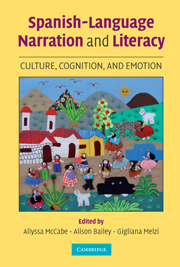Book contents
- Frontmatter
- Contents
- List of Contributors
- Preface
- Acknowledgments
- 1 Introduction
- PART ONE PARENT–CHILD NARRATIVES
- 2 Cultural Variations in Mother–Child Narrative Discourse Style
- 3 Early Sociocommunicative Narrative Patterns During Costa Rican Mother–Infant Interaction
- 4 Lessons in Mother–Child and Father–Child Personal Narratives in Latino Families
- 5 Evaluation in Spanish-Speaking Mother–Child Narratives: The Social and Sense-Making Function of Internal-State References
- 6 Love, Diminutives, and Gender Socialization in Andean Mother–Child Narrative Conversations
- PART TWO DEVELOPING INDEPENDENT NARRATION
- PART THREE NARRATIVE LINKS TO LITERACY AND OTHER SCHOOL ACHIEVEMENTS
- Author Index
- Subject Index
- References
2 - Cultural Variations in Mother–Child Narrative Discourse Style
Published online by Cambridge University Press: 05 June 2012
- Frontmatter
- Contents
- List of Contributors
- Preface
- Acknowledgments
- 1 Introduction
- PART ONE PARENT–CHILD NARRATIVES
- 2 Cultural Variations in Mother–Child Narrative Discourse Style
- 3 Early Sociocommunicative Narrative Patterns During Costa Rican Mother–Infant Interaction
- 4 Lessons in Mother–Child and Father–Child Personal Narratives in Latino Families
- 5 Evaluation in Spanish-Speaking Mother–Child Narratives: The Social and Sense-Making Function of Internal-State References
- 6 Love, Diminutives, and Gender Socialization in Andean Mother–Child Narrative Conversations
- PART TWO DEVELOPING INDEPENDENT NARRATION
- PART THREE NARRATIVE LINKS TO LITERACY AND OTHER SCHOOL ACHIEVEMENTS
- Author Index
- Subject Index
- References
Summary
Key Words: mother-child narratives, Latino children, Spanish, mother-child book sharing, cultural variations
ABSTRACT
Children develop narrative ability in the context of the conversations they have with significant others, mainly family members. Within these conversations, children acquire language and literacy and become socialized to the discourse patterns, beliefs, and values of the community in which they live. Recent research has begun to highlight that Latino mothers scaffold their children's narratives differently than might mothers from other cultures. The goal of the current study was to explore how Peruvian, European American, and Puerto Rican mothers of comparable socioeconomic backgrounds, living in their country of origin, scaffolded their children's narratives in a semistructured book-sharing paradigm. Specifically, the study addressed two main questions: (1) Do variations exist in the styles that Puerto Rican, European American, and Peruvian mothers use to engage their children while sharing a wordless children's picture book? (2) Are there cultural preferences in these styles?
As part of a larger study, 45 mothers were visited in their home and asked to share a wordless children's picture book with their children. Book-sharing interactions were audiotaped, transcribed, and verified using a standardized format and coded at the utterance level. Results of a cluster analysis revealed two book-sharing styles that hinged on the degree to which mothers provided or requested narrative information from their children. Storytellers provided rich narrative information to their children and took control of the narrative, whereas storybuilders coconstructed the story with their children, creating a story together.
- Type
- Chapter
- Information
- Spanish-Language Narration and LiteracyCulture, Cognition, and Emotion, pp. 6 - 33Publisher: Cambridge University PressPrint publication year: 2008
References
- 16
- Cited by



